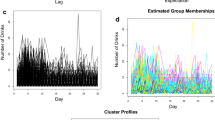Abstract
The mixture autoregressive (MAR) model regards a time series as a mixture of linear regressive processes. A self-organizing algorithm has been used together with the LMS algorithm for learning the parameters of the MAR model. The self-organizing map has been used to simplify the mixture as a winner-takes-all selection of local models, combined with an autocorrelation coefficient based measure as the similarity measure for identifying correct local models and has been shown previously being able to uncover underlying autoregressive processes from a mixture. In this paper the self-organizing network is further generalized so that it fully considers the mixing mechanism and individual model variances in modeling and prediction of time series. Experiments on both benchmark time series and several financial time series are presented. The results demonstrate the superiority of the proposed method over other time-series modeling techniques on a range of performance measures including mean-square-error, prediction rate and accumulated profits.
Preview
Unable to display preview. Download preview PDF.
Similar content being viewed by others
References
Allinson, N.M., Yin, H.: Interactive and semantic data visualization using self-organizing maps. In: Proc of IEE Colloquium on Neural Networks in Interactive Multimedia Systems (1998)
Bollerslev, T.: Generalized autoregressive conditional heteroskedasticity. Journal of Econometrics 31, 307–327 (1986)
Box, G., Jenkins, G.: Time Series Analysis: Forecasting and Control. Holden-Day, San Francisco (1970)
Cao, L.J.: Support vector machines experts for time series forecasting. Neurocomputing 51, 321–339 (2002)
Chen, S., Billings, S.A., Cowen, C.F.N., Grant, P.M.: Practical identification of NARMAX models using radial basis functions. Int. Journal of Control 52, 1327–1350 (1990)
Dablemont, S., Simon, G., Lendasse, A., Ruttiens, A., Blayo, F., Verleysen, M.: Time series forecasting with SOM and local non-linear models - Application to the DAX30 index prediction. In: Proc. of WSOM 2003, pp. 340–345 (2003)
Kohonen, T.: Self-Organizing Maps. Springer, Heidelberg (1997)
Enders, W.: Applied Econometric Time Series, 2nd edn. John Wiley & Sons, Chichester (2004)
Haykin, S.: Neural Networks - A Comprehensive Foundation, 2nd edn. Prentice-Hall, Englewood Cliffs (1998)
Koskela, T.: Time Series Prediction Using Recurrent SOM with Local Linear Models, Helsinki University of Technology (2001)
Lampinen, J., Oja, E.: Self-organizing maps for spatial and temporal AR models. In: Proc. of 6th SCIA Scandinavian Conference on Image Analysis, Helsinki, Finland, pp. 120–127 (1989)
Martinetz, T., Berkovich, S., Schulten, K.: Neural-gas network for vector quantization and its application to time-series prediction. IEEE Trans. Neural Networks 4, 558–569 (1993)
Ni, H., Yin, H.: Time-series prediction using self-organizing mixture autoregressive network. In: Yin, H., Tino, P., Corchado, E., Byrne, W., Yao, X. (eds.) IDEAL 2007. LNCS, vol. 4881, pp. 1000–1009. Springer, Heidelberg (2007)
Ni, H., Yin, H.: Self-organizing mixture autoregressive model for non-stationary time series modeling. Int. Journal of Neural Networks 18, 469–480 (2008)
Strickert, M., Hammer, B.: Merge SOM for temporal data. Neurocomputing 64, 39–72 (2005)
Voegtlin, T., Dominey, P.F.: Recursive self-organizing maps. Neural Networks 15, 979–991 (2002)
Wong, C.S., Li, W.K.: On a mixture autoregressive model. Journal of the Royal Statistical Society, Series B (Statistical Methodology) 62 (part1), 95–115 (2000)
Yin, H., Allinson, N.M.: Self-organizing mixture networks for probability density estimation. IEEE Trans. on Neural Networks 12, 405–411 (2001)
Author information
Authors and Affiliations
Editor information
Editors and Affiliations
Rights and permissions
Copyright information
© 2009 Springer-Verlag Berlin Heidelberg
About this paper
Cite this paper
Yin, H., Ni, H. (2009). Generalized Self-Organizing Mixture Autoregressive Model for Modeling Financial Time Series. In: Alippi, C., Polycarpou, M., Panayiotou, C., Ellinas, G. (eds) Artificial Neural Networks – ICANN 2009. ICANN 2009. Lecture Notes in Computer Science, vol 5768. Springer, Berlin, Heidelberg. https://doi.org/10.1007/978-3-642-04274-4_60
Download citation
DOI: https://doi.org/10.1007/978-3-642-04274-4_60
Publisher Name: Springer, Berlin, Heidelberg
Print ISBN: 978-3-642-04273-7
Online ISBN: 978-3-642-04274-4
eBook Packages: Computer ScienceComputer Science (R0)




